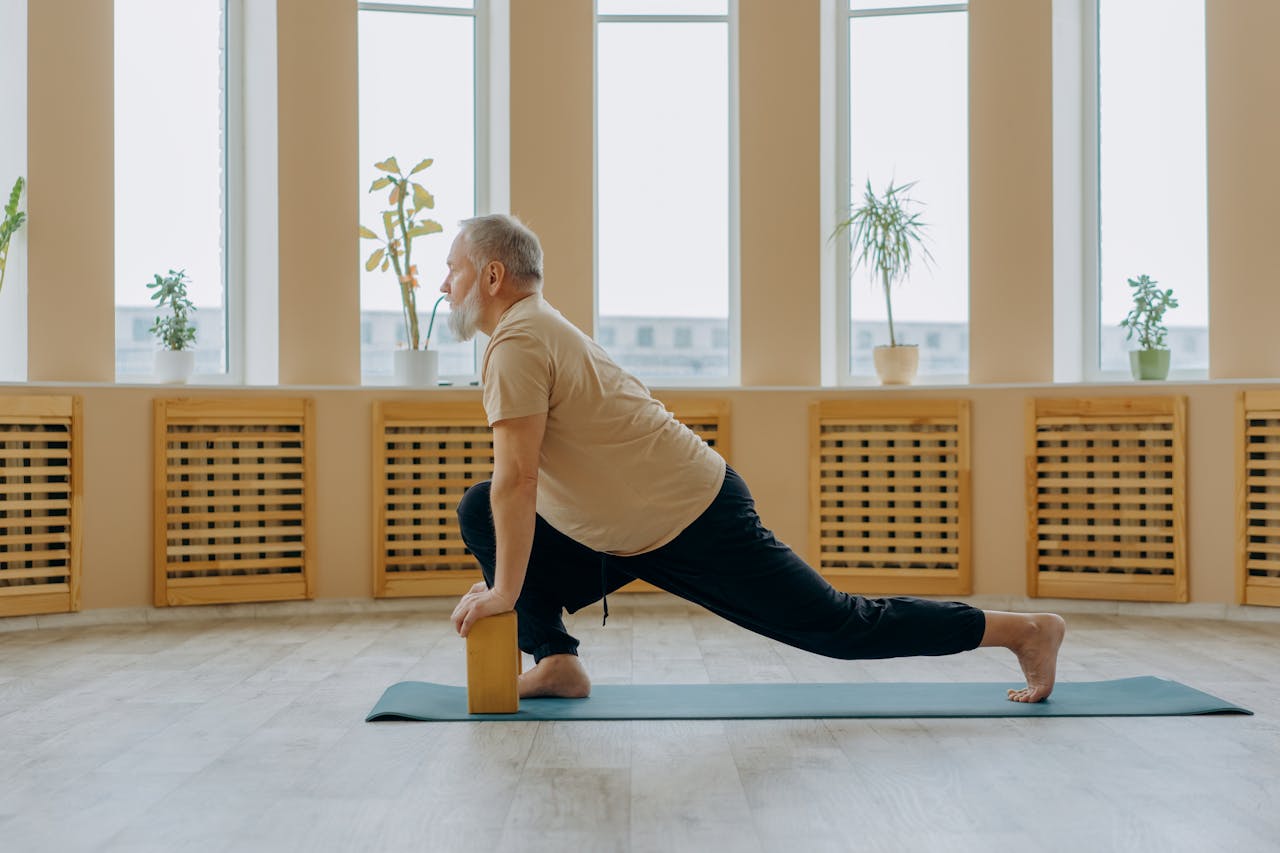
Table of Contents
Anjaneyasana is a lunging pose with the torso upright and arms overhead. Generally, it is taught with the back knee bent and on the ground and the top of the foot on the floor with the back toes pointing rearwards.
Sanskrit origins of Anjaneyasana
Anjaneya translates as the son of Anjani. It is another name for Hanuman, the term also given to the front-to-back splits.
The story tells that Hanuman, the monkey god, made a giant leap from India to the island of Sri Lanka to rescue Sita, the beloved of King Ram, from the clutches of the demon Ravana. As a result, the splits became a representation of this leap.
As a youth, Hanuman mistook the sun for fruit and jumped to take a bite. The sun god Surya threw a lightning bolt at him for impertinence, marking his jaw. The Sanskrit for the jaw is Hanu. The pose Anjaneyasana resembles the young Hanuman, then named Ajanaeya, reaching for the sun before he became Hanuman. Anjaneyasana is a warmup for Hanumanasana.
Benefits of Anjaneyasana
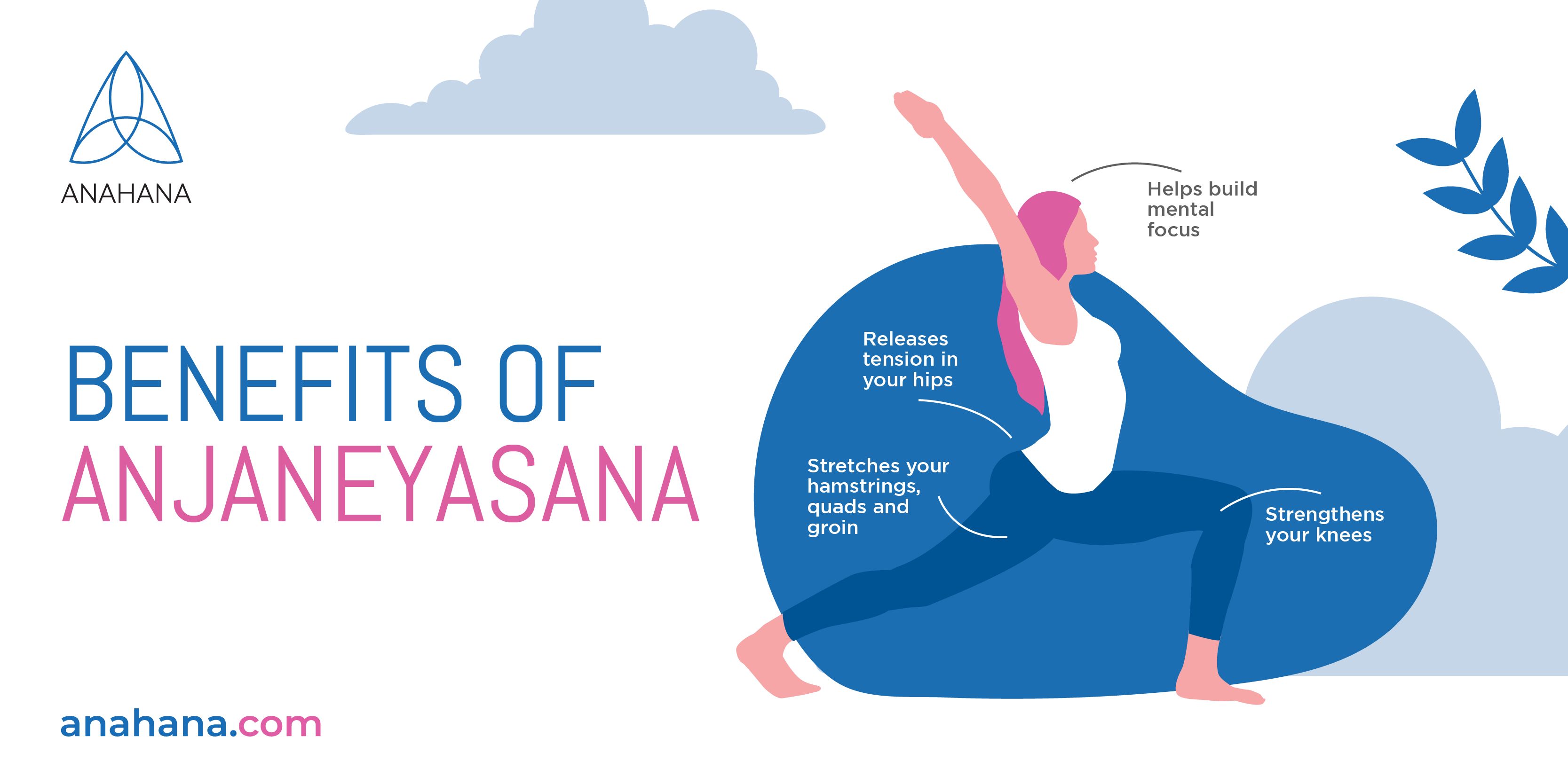
-
Strengthening the upper back, mainly if the spinal erectors are activated.
-
Stretching of the front of the abdomen and the front of the ribcage.
-
If the shoulders are active, the pose helps to strengthen and stretch the shoulders muscles.
-
Foot and ankle strengthening.
-
If the front leg hip is activated, then it helps to strengthen that hip in flexion.
-
Improving knee stability when bent.
-
Stretching and strengthening the hip flexors of the back leg.
-
If the back leg is exerted with an upwards pull (with the pelvis sinking), the pose strengthens and actively stretches the hamstrings.
-
This pose can help to strengthen and balance the SI joints, particularly if paying attention to the knees, hip joints, hip bones, and the lower part of the spine (lumbar spine and sacrum).
-
If looking up, this pose can stretch the front of the neck. A suggestion is to keep the back of the neck engaged and to actively lift the front ribs while pulling down on the backs of the ribs while drawing the ear holes away from the shoulders to maintain length in the cervical spine during a backbend.
-
While often done with the front of the knee over the middle of the foot (front leg), Anjaneyasana can be done with the knee far ahead of the toes and the back of the knee closed. Note that special care should be taken if working towards this variation. However, doing this variation, particularly with the foot, knee, or hip or all of them active, then it can help improve knee health.
-
If the front foot and back knee are on the same, it helps to improve balance. One way to do this is to make the front foot and ankle active so that you have at least one point of stability. Another option is to actively press the toes of the back foot into the floor. To aid in balance, partially activate the back knee and hip.
-
Improving concentration. While keeping the base stable, aim to maintain the backbend and the arm position. Repeatedly scan the body with awareness for better focus.
Anjaneyasana Contraindications
Anjaneyasana should not be performed in the following conditions:
- Hip injury
- Low back injury
- Groin injury
- Knee injury
- High blood pressure
Preparatory poses for Anjaneyasana
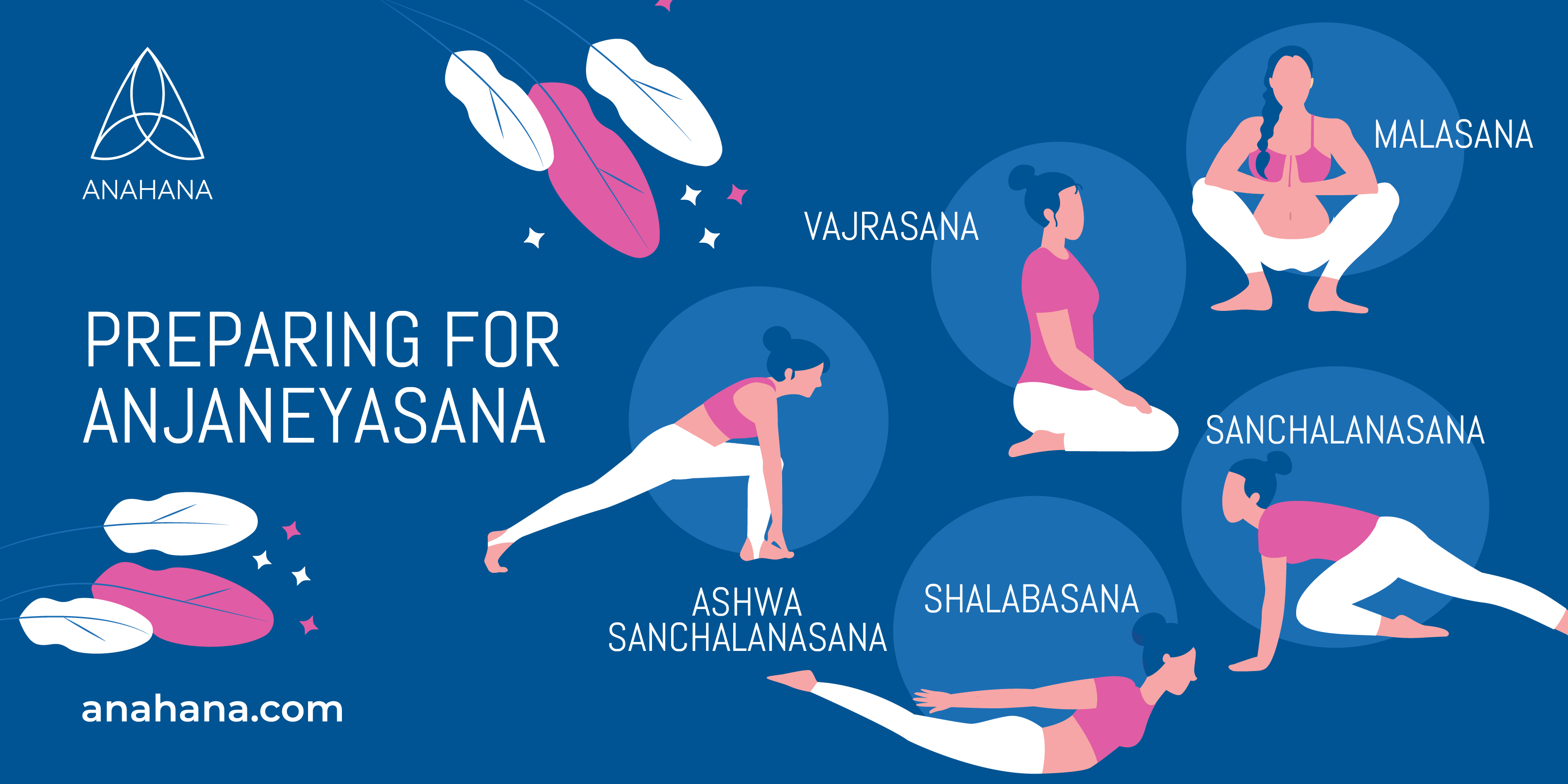 Preparatory poses for Anjaneyasana fall into two basic categories for the legs:
Preparatory poses for Anjaneyasana fall into two basic categories for the legs:
- Preparatory poses for the front leg
- Preparatory poses for the back leg
For the front leg, in Anjaneyasana, preparatory poses include Vajrasana, also known as thunderbolt or diamond pose, or simple kneeling. Poses with one leg in the kneeling position can also be used.
Malasana or deep squat help to warm up the front leg. Akin to a half squat, Utkatasana is helpful to improve strengths in addition to Virabhadrasana l (or warrior pose). The warrior pose is done with the back knee straight and the rear foot flat on the ground. If you point the back knee down, this pose may act as a preparatory pose for the back leg of Anjaneyasana.
For the back leg, preparatory poses can include Ashwa Sanchalanasana (equestrian or horse stepping pose) and bird dog.
Using bird dog, focus on lifting the back leg while keeping the back knee pointing down.
Even though in Anjaneyasana the back knee is bent, memorize the feeling of lifting the back thigh while in bird dog and work at applying it to the back leg, perhaps first in Ashwa Sanchalanasana followed by Anjaneyasana.
The third category is preparatory poses for the back. Because the crescent moon pose involves an active back bend, in which the spinal erectors are active, one way to prepare for this is to practice activating the spinal erectors. Preparation is to practice lifting your head and chest while prone as you do the Shalabasana (locust, or “rising locust”) pose.
Poses related to Anjaneyasana
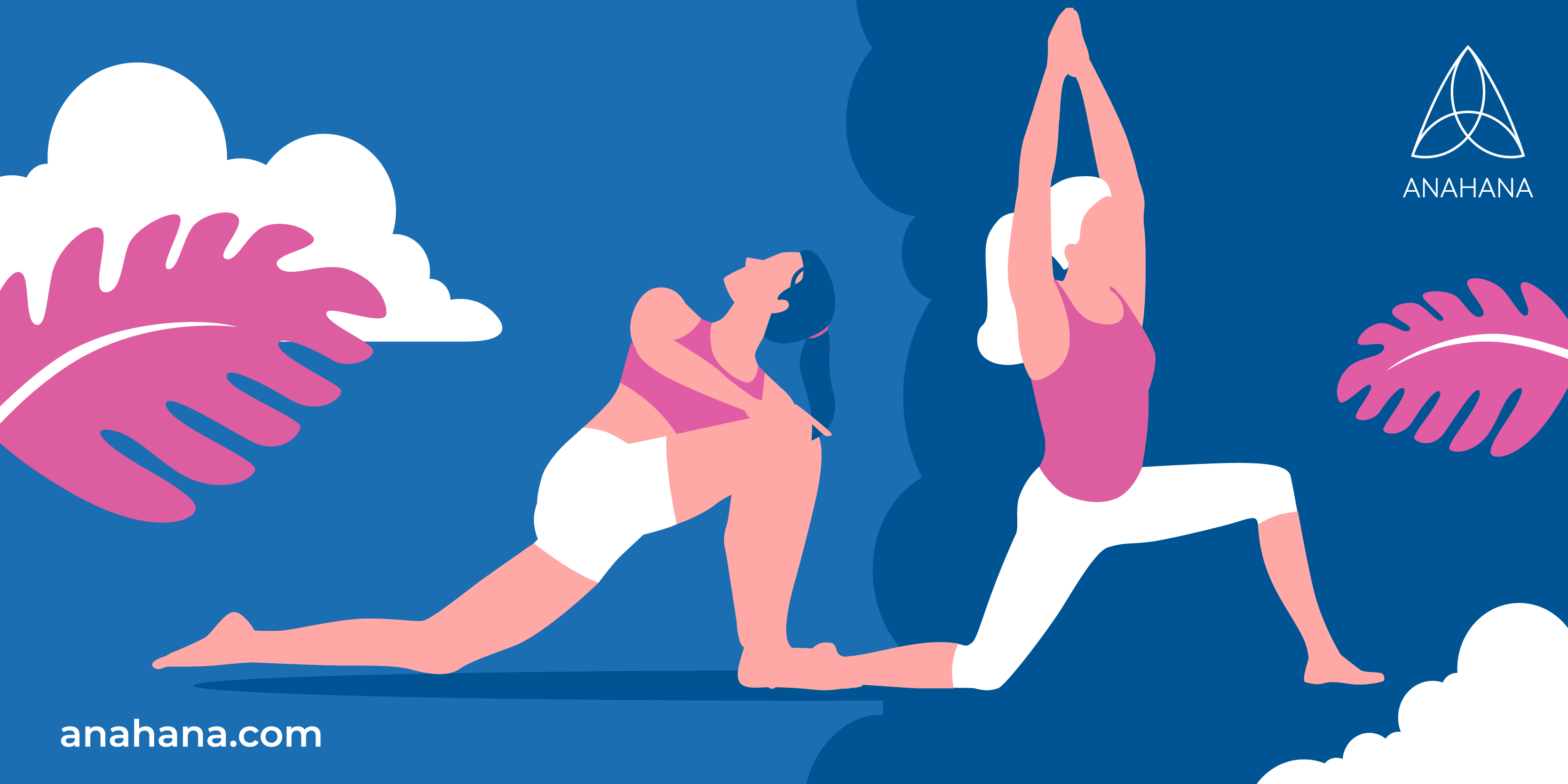 Ashwa Sanchalanasana, or horse riding pose, is another low lunge pose with the hands on the floor. Virabhadrasana, aka Warrior l, is similar since the torso is upright with the arms overhead while the back knee is kept straight, the back foot is flat on the floor, and the leg rotates outwards to facilitate this.
Ashwa Sanchalanasana, or horse riding pose, is another low lunge pose with the hands on the floor. Virabhadrasana, aka Warrior l, is similar since the torso is upright with the arms overhead while the back knee is kept straight, the back foot is flat on the floor, and the leg rotates outwards to facilitate this.
Moving into Anjaneyasana from kneeling
Get into this pose from a kneeling position with your hips lifted.
- Step the right foot onto the floor, close to the left knee.
- Place the hands on the floor and slide your left foot and left knee rearwards. As your hips move back, you can focus on sinking your hips.
- Once your knee and foot have slid back sufficiently, you can brace your front leg and lift your torso upright.
- Keeping your torso upright, tilt your pelvis forwards and actively bend your spine backward.
- Protract your shoulder blades and bend your elbows out to the sides. Maintaining the protraction, reach your shoulder blades upwards, allowing the bottom tips to side outwards and forwards around the sides of your ribcage while the top “peaks” of your shoulder blades move upwards and inwards. Reach your elbows up and out to the sides.
- From there, reach your hands upwards, straightening your elbows and bringing your hands together, with elbows straight if possible, over your head.
- You can draw your ear holes back and up, away from your shoulders, and either looks straight ahead, keeping the back of your neck feeling long, or carefully look up. In this instance, you may find activating the front of your neck helpful. This may be easier if you touch your teeth together without grinding them and then activate the muscles of your lower jaw from there.
An alternative method for entering Anjaneyasana from upright kneeling is as follows:
- From the hips lifted, kneeled position, step your right foot forwards, straighten the right knee, sliding the heel forwards while keeping your hips over the left knee.
- From there, slowly bend the right knee, sending the hips forward and flattening the foot to the floor.
- Adjust the position of your front foot, shifting it forwards or rearwards.
- From here, follow the instructions from the original explanation above.
Anjaneyasana as part of Surya Namaskar or sun salutations
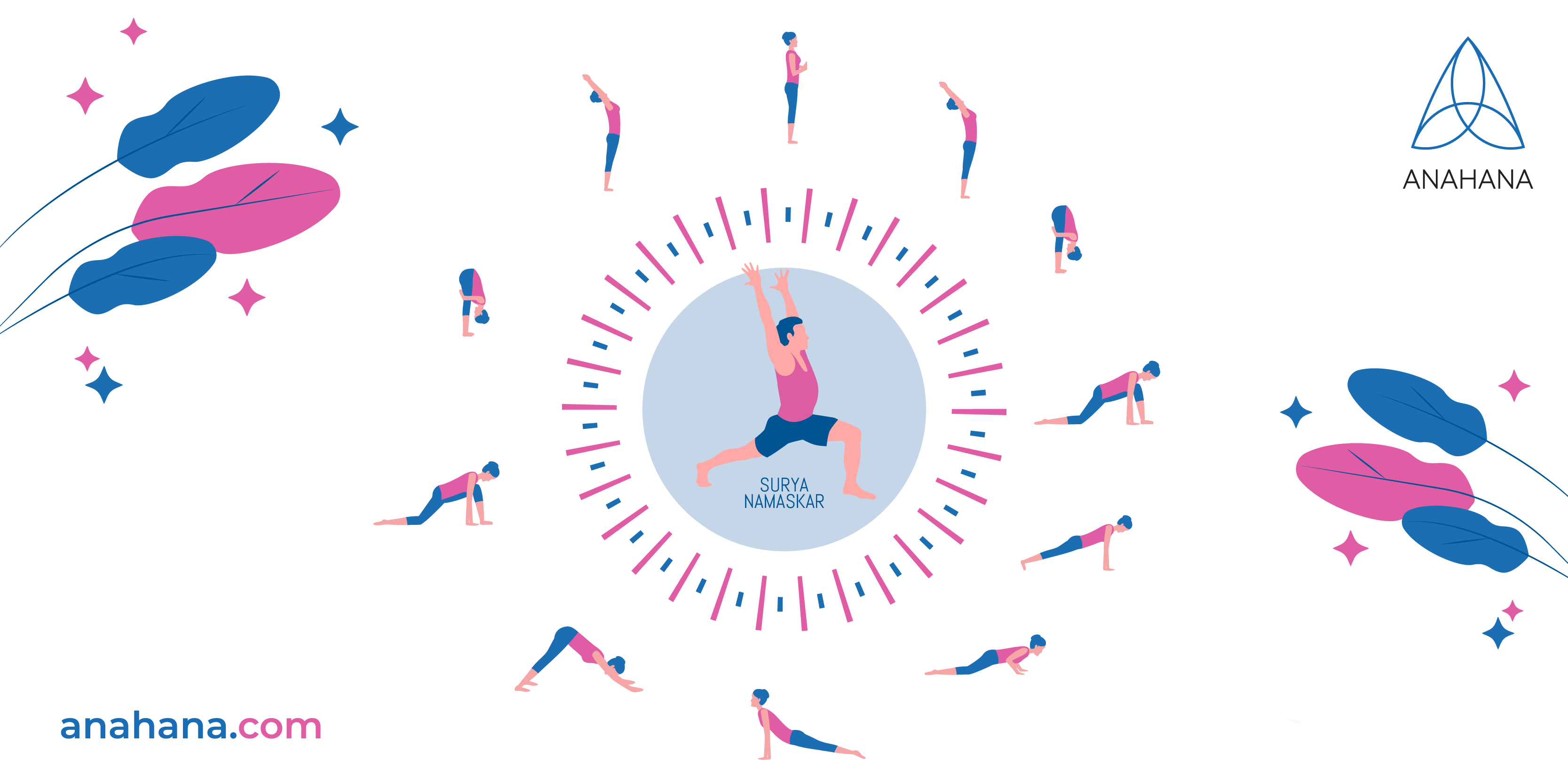 Surya Namaskar, or sun salutations, are a sequence of ashtanga yoga poses used as a warmup in yoga classes or as a way of honoring the divine sun. Anjaneyasana is practiced in some versions of Surya Namaskar.
Surya Namaskar, or sun salutations, are a sequence of ashtanga yoga poses used as a warmup in yoga classes or as a way of honoring the divine sun. Anjaneyasana is practiced in some versions of Surya Namaskar.
If practicing Anjaneyasana as part of Surya Namaskar, chances are that you’ll be moving from Anjaneyasana into Adho Mukha Svanasana (downward facing dog), followed by the transition from Adho Mukha Svanasana back into Anjaneyasana.
Moving into Anjaneyasana from downward facing dog pose
If moving into Anjaneyasana from a downward-facing dog pose, you’ll have to lunge one foot forward. If the left leg steps forwards, you can prepare by shifting your body weight to the right so that your right arm and right foot bear most of your weight. You can lift your left foot and if needed, your left hand. Raising the leg hand may give you the room necessary to get your leg forwards. You can also use it to help pull the leg forwards if required.
Entering Anjaneyasana from a standing position
It is possible to get into Anjaneyasa from a standing position. One option is to bend forwards into Uttanasana and step a foot back. Another is to step back and turn the front knee while leaning forward and placing the hands on the floor. Set up your legs as described previously, sliding the front foot further forwards or the rear foot rearwards, and brace the front leg enough to lift the hands. Next, actively bend the spine backward, allowing the pelvis to tilt forwards.
Another option is to activate the hips. While keeping your hips active, use your hip muscles to tilt the pelvis forwards. Actively bend the spine backward and reach the arms up overhead.
Making Anjaneyasana Comfortable
With the back knee to the floor in Anjaneyasana, placing a folded blanket underneath the knee can help to increase knee comfort. If covering is not available, substitute it with a towel, a sofa cushion, or even a yoga block if it is of the soft kind. Another option is to fold the side or the back of a yoga mat.
References
How to Do Crescent Lunge Pose (Anjaneyasana) in Yoga
What is Anjaneyasana? - Definition from Yogapedia
Anjaneyasana {Low Lunge Pose}-Steps and Benefits - Sarvyoga
Anjaneyasana: The Lunge Pose | Gaia
The Story Behind Hanumanasana/Monkey Pose — Balance Garden
The Story Behind How the Yoga Pose Hanumanasana (Splits or Monkey Pose) Got Its Name
Disclaimer
The contents of this article are provided for informational purposes only and are not intended to substitute for professional medical advice, diagnosis, or treatment. It is always recommended to consult with a qualified healthcare provider before making any health-related changes or if you have any questions or concerns about your health. Anahana is not liable for any errors, omissions, or consequences that may occur from using the information provided.

By: Anahana
The Anahana team of researchers, writers, topic experts, and computer scientists come together worldwide to create educational and practical wellbeing articles, courses, and technology. Experienced professionals in mental and physical health, meditation, yoga, pilates, and many other fields collaborate to make complex topics easy to understand. Anahana is also home to specialists in crystals, tarot, angel numbers, astrology, life path numbers, zodiac signs, and horoscopes. By combining evidence-based wellness with spiritual and energetic practices, the team offers clear, trustworthy guidance for both mind-body health and modern spirituality.